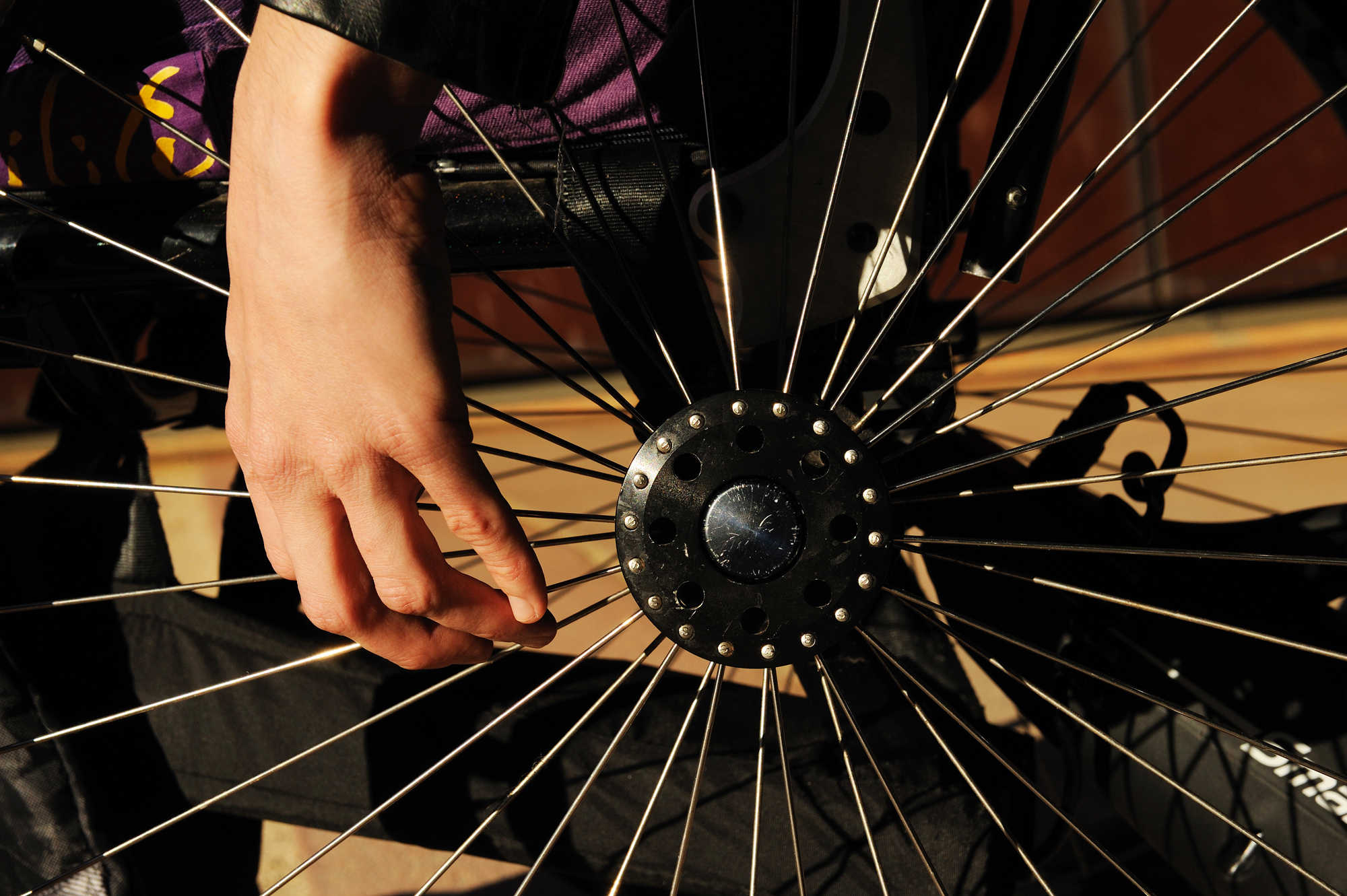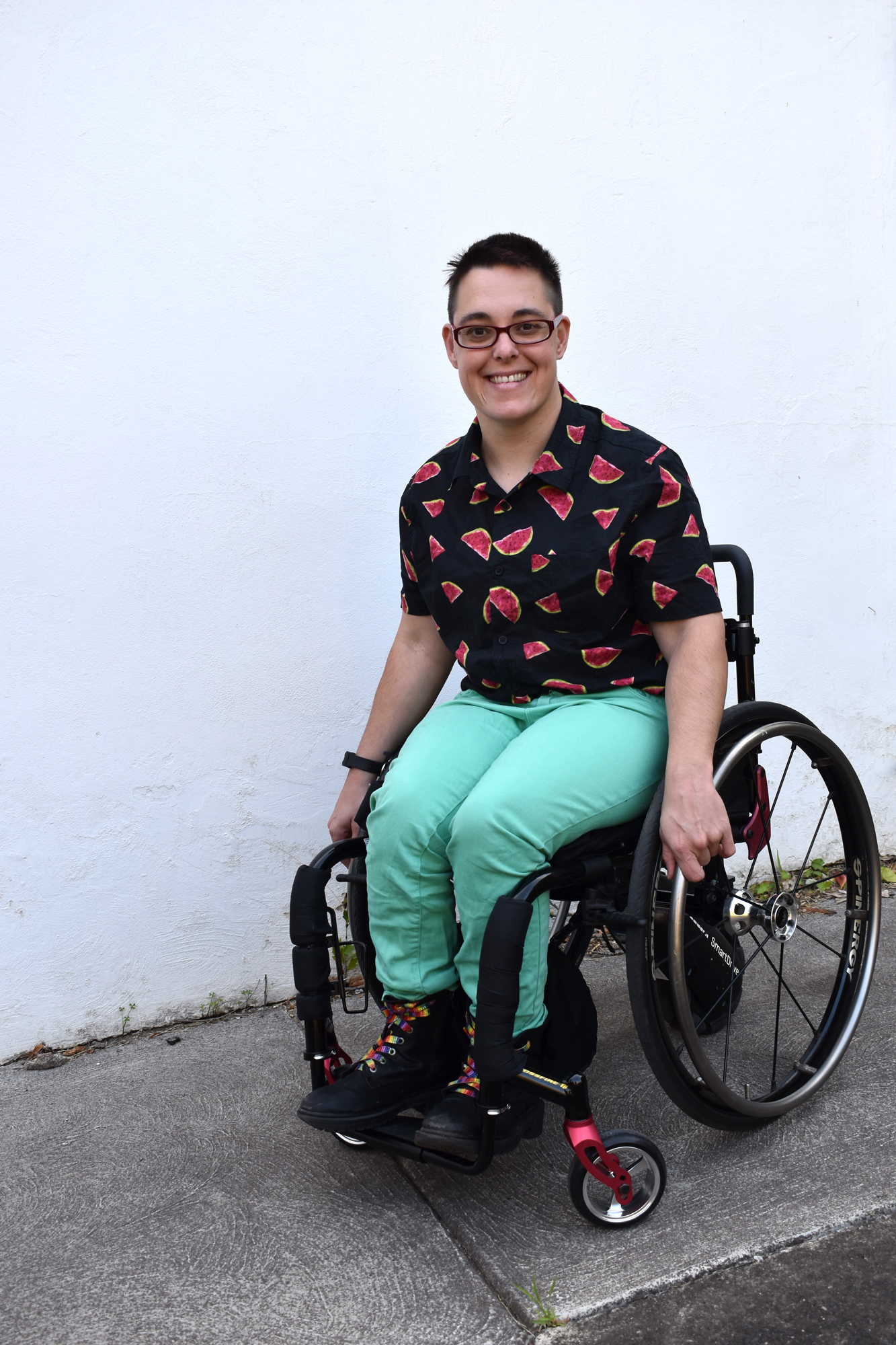Navigating disability design

Disability is not a personal problem, but a socio-political question: a question of who is included, and who is excluded from our cities. Writer, educator and activist Jax Jacki Brown unpacks the shortcomings in disability design as they traverse Melbourne in search of an accessible tram stop.
I am waiting at the lights. I feel his eyes on me, watching me, wondering… He takes the plunge.
“What happened?” he asks.
“What?” I reply as though I haven’t heard the question or am unsure of his meaning. In truth, I know exactly what he means.
“Was it an accident? I broke my leg once and was in a wheelchair for a bit, it sucked. It must be tough.”
I beg for the lights to change so this conversation will end. I want to tell him disability is not what he thinks it is. That my life is not what he has been told it must be: tragic or, conversely, inspirational. I want him to know that my life is rich, full and complex, just like anyone else’s.
The lights change. The little green man signals to walk.
He asks if I want a push. “No, I’m fine. I’ve got it, mate,” I say.
“OK,” he replies. “It’s important to try and stay positive, hey,” and he sprints to the other side. I wish I was quick-witted enough to quote Stella Young and yell after him, “No amount of smiling at a flight of stairs has ever turned it into a ramp!” But he’s gone.
Disability is a design problem, not a personal issue of the body or mind. Let me unpack that for you as I wheel my way home.
I get to the other side of the road and the curb cut is steep, really steep. I push hard and make it onto the footpath. Now, for my favourite bit of the journey home: going down the hill towards the tram stop. I feel the soft tuk, tuk, tuk as my wheels roll over the joins in the pavement, my fingers running over my smooth wheel rims, expertly steering my wheelchair. I know this metal, this frame; it’s like a second skin. My wheelchair and I have lived together, every day, for over seven years, spending each moment touching, moving. My wheelchair forms a big part of how I am seen in the world, how others relate to me, and how I see myself. It is a huge part of how I experience places and spaces, and I know how the power of design can include or exclude people.
I wait at the tram stop for a wheelchair-accessible tram. At peak hour, they arrive every few minutes, but at other times the wait can be 20 or 30 minutes, while inaccessible, old-style trams regularly arrive and depart. An accessible one arrives, and I push onto it as we head towards Flinders Street Station. This tram goes to the top of my street but there is no ‘super stop’, so I cannot get off there (a super stop has a raised platform that is level with the low-floor trams). We arrive at Flinders Street and the doors open. There is a small drop from the tram to the platform, and there’s a gap between them too, big enough that I’ve got my small, front caster wheels stuck in it before. It is not safe for many other people with various disabilities and mobility equipment. It used to be level before the platform was upgraded. This is a violation of the Disability Discrimination Act 1992 (DDA), making an existing service no longer fully accessible, but challenging it would require individual cases filed by people with disabilities. The process of lodging a complaint is arduous and rarely results in action taken.
Melbourne’s tram network is a prime example of how people with disabilities experience discrimination in the built environment. Trams are the quickest and easiest way to get around, but for many people they remain largely inaccessible.
Planning around super stops and accessible trams can add hours to a person’s day, because most stops and trams are not accessible for people using mobility devices. While able people navigate this city with ease, taking it for granted they can take the quickest, simplest route, I often have to take two or more trains or buses where others can take a single tram ride to reach the same destination. Sometimes, I watch able people jumping on and off trams and trains and dream of a world where I would be able to take access for granted; where I would be able to get the tram directly to my place of work from home, instead of wheeling to the accessible station in the rain, and then wheeling another 10 minutes at the other end.
Melbourne was voted the world’s most liveable city by the Economist Intelligence Unit for seven years in a row, before losing the title to Vienna in 2018. But it begs the question: liveable for whom? Under the EIU assessment, liveability is assessed across five categories: stability, healthcare, culture and environment, education and infrastructure. In 2018, Melbourne scored maximum points in the infrastructure category. This demonstrates that true, universal accessibility is not given equal weight to other considerations when cities are being designed, assessed, built. There are many public buildings I cannot access because there is no ramp, or the doorways inside are too narrow. Further, there is often no accessible toilet, which is a basic requirement to make a building useable for someone with a disability. I know where Melbourne’s accessible toilets are, the way non-disabled people know the city by its famous landmarks or good restaurants.

I wish I was quick-witted enough to quote Stella Young and yell after him, “No amount of smiling at a flight of stairs has ever turned it into a ramp!”
The DDA protects the right to access buildings, yet no law requires buildings to be accessible. The Disability (Access to Premises – Buildings) Standards 2010, as part of the Building Code of Australia (BCA), set out accessibility standards for new buildings. However, compliance is not mandatory. Organisations can claim that providing access in accordance with the DDA would cause ‘unjustifiable hardship’. The main factor the Federal or Magistrates’ Court will consider in assessing unjustifiable hardship is financial; would, in the circumstances, providing access cost the person/organisation too much money? They also consider technical difficulties, the intended use of the building and any impact the changes might have on heritage features. The BCA has a similar unjustifiable hardship clause. Combined, these provisions weaken the DDA and the BCA, meaning that access to the built environment is not safeguarded for people with disabilities.
How do we, as a society, balance the tension between wanting to preserve the history imbued in our heritage architecture with a push to provide greater access and universal design principles? Inaccessible buildings hold a certain history for people with disabilities. There was a time, not so long ago, when people with disabilities were locked up in institutions. This exclusion is chiselled into the architecture of buildings we cannot access. Our city holds so much history, but history tends to highlight the dominant narrative (white, able-bodied) and obscure marginalised voices. Now, the vast majority of people with disabilities are no longer in institutions and we ask to be afforded the same rights and access which non-disabled people take for granted.
Disability is not a personal problem, but a socio-political question. A question of who is included and who is excluded. If we are to create a society that is truly inclusive for everyone, we need to ensure that all people can participate fully. That means being able to access the city – its buildings, public transport, parks and footpaths – with dignity. Will our architecture and urban design continue to perpetuate these power imbalances, or seek to redress them and create a society which is accessible and inclusive for everyone?
Thank you, Jax, for taking the time to educate us on how to think about accessibility in terms of design. Jax is a prominent writer, speaker and educator on disability and LGBTIQ rights: you can follow their work on their website. Or see them in person: they will be speaking at the upcoming Broadside Festival on 9-10 November.